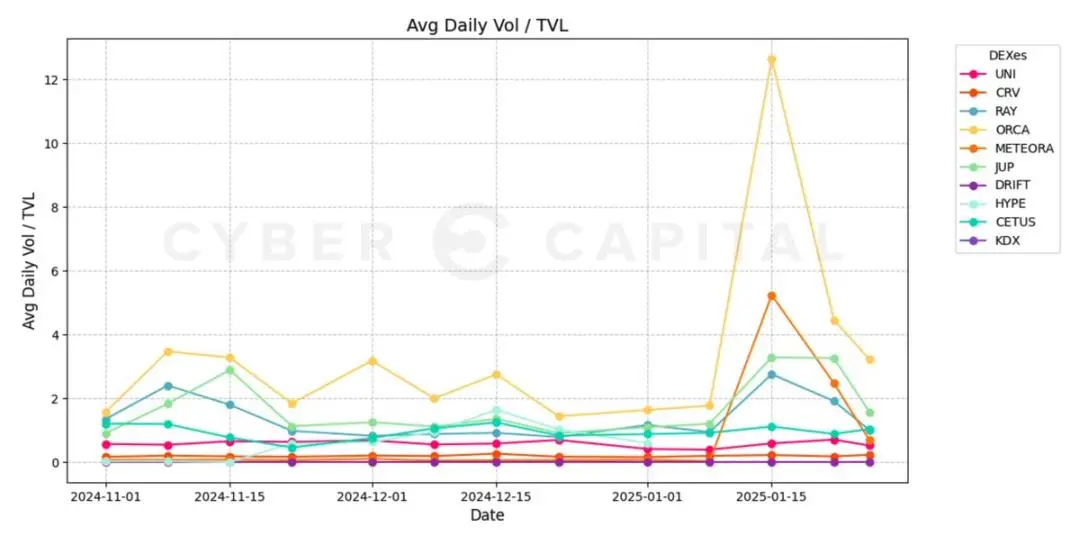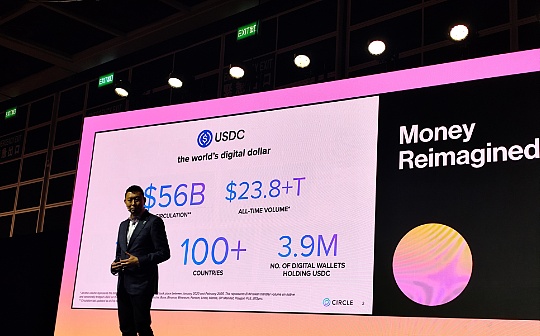In-depth analysis of Solana's four major DEXs: Raydium, Jupiter, Orca and Meteora. Which one is better?

Reprinted from chaincatcher
02/19/2025·2MOriginal title:Introduction: Solana's Evolving DeFi
Landscape
Original author: vik0nchain, researcher at Cyber Capital
Original translation: Luffy, Foresight News
From the fourth quarter of 2024 to the beginning of 2025, Solana's competitive landscape of DeFi ecosystem gradually emerged, mainly reflected in the rise of aggregators, user experience (UX) abstraction, major integration and evolving token economic standards. Although these changes are not obvious at first, recent data have clearly shown an impact, highlighted in the reallocation of liquidity, fee generation and changes in market share.
This analysis provides an in-depth analysis of the liquidity positioning of major decentralized exchanges (DEXs) based on Solana, Raydium, Jupiter, Orca and Meteora, focusing on their strengths, weaknesses, and potential investment impacts over existing and emerging competitors .
Investment analysis framework
Raydium (RAY) has a positive outlook: deep liquidity and repurchase
advantages
· Dominance of liquidity and trading volume: Raydium remains the most liquid and most frequently used decentralized exchange in the Solana ecosystem. More than 55% of transactions routed through Jupiter are settled on Raydium. In addition, Raydium is in the market leading position with the long-standing leading Uniswap among all blockchain decentralized exchanges, and sometimes even surpasses Uniswap, with its full dilution valuation (FDV) and market capitalization being only about three points for Uniswap one.
· Raydium/Uniswap Fully diluted valuation ratio: USD 2.872828346 billion/ USD 9.102379018 billion=31.5%
· Raydium/Uniswap Market Cap Ratio: USD 1505604427 billion/ USD 5465824531 billion=27.5%

· Pump.fun Integration: A key partnership including integration with Pump.fun has increased transaction volume and protocol stickiness due to the migration of all new Meme pools to Raydium.
· Token Repurchase: Raydium's 12% fee repurchase program has repurchased tokens that exceed 10% of the total supply, significantly reducing the pressure on selling. It is worth noting that the number of Raydium repurchases is significantly greater than the number held by centralized exchanges.

Jupiter (JUP) has a positive outlook: market-leading aggregators
· Liquidity Aggregation Advantages: Jupiter plays a key role as the dominant aggregator of Solana.
· Acquisition of Moonshot: Acquisition of Moonshot enables Jupiter to integrate deposit/withdraw channels within its decentralized exchanges, increasing competitiveness by simplifying user experience.
· Unlocking pressure: Jupiter faces a 127% supply increase due to token unlocking, which brings medium-term inflation risks. Despite the recent announcement of a repo mechanism, the internal estimated annual repo rate is 2.4%, which provides some support for the token economy but has limited role in competition with Raydium.
· Business model: Since the aggregator fee is charged additionally above the underlying protocol fee, the aggregator model faces difficulties in the low-cost dimension.
· Lack of competitors: As the first aggregator on Solana, Jupiter lacks strong competitors.
Meteora's optimistic outlook: Rising liquidity aggregator
· Aggregation liquidity efficiency: Unlike independent decentralized exchanges, aggregators like Meteora essentially have lower downside risks and more stable capital efficiency.
· Token issuance Catalyst: The successful issuance of Meteora tokens may change liquidity preferences and provide long-term support for its market positioning. Unlike industry LP leader Kamino, MET points are not publicly displayed on the user interface. Additionally, there has been no official statement on airdrops since the MET points system was first announced more than a year ago. Although liquidity providers can gain higher returns elsewhere in the ecosystem (such as lulo.fi), market positioning and airdrop expectations may be the main drivers of liquidity providers.
· Total locked value (TVL) retention: Meteora has developed with major events such as Pengu airdrop and the launch of Memecoin related to Trump and Melania. While the Vol/Total Lock Value (Vol/TVL) ratio of many pairs increased due to temporary demand during the launch of Memecoin, Meteora's total lock value continued to rise after the event, showing a good retention rate.
· Integration Development: Virtuals moved to Solana in the first quarter of 2024 and announced integration with the Meteora liquidity pool.


Orca's prospects are pessimistic: insufficient liquidity retention
· Inadequate liquidity depth: Despite its extremely high efficiency, Orca's capital pool size is significantly smaller than Raydium, resulting in higher slippage in large-scale transactions.
· Market positioning issues: Jupiter's routing mechanism prioritizes deeper liquidity trading platforms, making emerging low-liquid decentralized exchanges and liquidity pools unattractive. The emergence of Meteora as a liquid aggregator further limits the competitive viability of non-dominant decentralized exchanges in the routing framework, because they are only routed when the slippage cost is lower than the fee premium of Meteora, and in This is extremely rare in addition to the surge in market demand.
· Limited liquidity provider incentives: Orca lacks a strong liquidity mining strategy, resulting in low long-term liquidity provider retention.
· Inefficient capital allocation: Unlike Meteora, Orca has not yet implemented automated revenue optimization and needs to manually manage LPs, resulting in more cumbersome user experience.
· Not optimistic liquidity trends: The upcoming Meteora token may completely attract liquidity providers from Orca, making it more difficult.
· Inadequate integration: The failure to reach a cooperation with Pump.fun in early 2024, and recently missed its cooperation with Virtuals, highlighting its competitive disadvantage in acquiring order flows for emerging retail-driven applications. Without the upcoming catalyst to reverse this trend, liquidity migration may continue. The above factors have caused Orca to be unable to retain the additional user volume obtained during peak network demand.
Key Catalysts and Risks
Catalysts to be concerned about
· Comparison of RAY repurchase and centralized exchange holdings: RAY's repurchase speed has now exceeded the total RAY held by centralized exchanges, strengthening the scarcity of tokens.
· Growth trend of total lock-in value: The continued dominance of Raydium, Jupiter and Meteora indicates the sustainability of long-term liquidity. Under high-pressure market conditions, the stickiness performance of emerging agreements is worth paying attention to and cannot be ignored.
· Partnership: Just as Pumpfun's integration brings significant liquidity to Raydium, Meteora's integration with Virtuals may have similar effects. Given the impact of cooperation on liquidity and total lock-up value of cooperation of this type, cooperation with lesser-known participants has attracted much attention.
· Meteora’s token issuance: This event may mark a turning point in Solana’s decentralized exchange liquidity allocation.
· Fee to market capitalization ratio: Orca shows extremely high efficiency in months of high demand, but its insufficient liquidity retention hinders long-term competitiveness. On the other hand, JUP faces the opposite situation, which is limited by its business model. Compared to the latest "popular project" Hyperliquid, Raydium incurs ten times the expenses at a full dilution valuation of one in eighth.

risk
· JUP's inflation pressure: Despite Jupiter's strong aggregator status, its large supply of tokens may create short-term price pressure. Decline in Orca’s market share: Orca may face sustained liquidity loss if the trend of liquidity provider migration continues. Meteora airdrop and token economy execution risk: Despite strong growth in early total lock-in value, its token economy and incentive structure remain untested.
Conclusion and investment prospects
Solana's decentralized exchange landscape is shifting towards higher efficiency and deeper liquidity concentration. Raydium's excellent liquidity positioning, active repurchase mechanism and market dominance make it a decentralized exchange with great investment confidence. Jupiter's aggregator role remains crucial and provides competitive barriers, but dilution of token supply forms a resistance in the near term. Once a competitive player, Orca faced serious challenges in liquidity retention and capital efficiency, becoming an increasingly vulnerable asset, demonstrating the dilemma of missing out on key integrations and difficulty competing head-on with mature players. Meteora is expected to rise after successfully launching its upcoming token.
According to our current theory, investment positions in decentralized exchanges should be concentrated in leading decentralized exchanges, decentralized exchange aggregators and liquidity aggregators for a given ecosystem, emerging players who meet catalyst standards, with emerging players who meet the catalyst standards in a given ecosystem You can also hold a small number of positions.

 panewslab
panewslab
 jinse
jinse